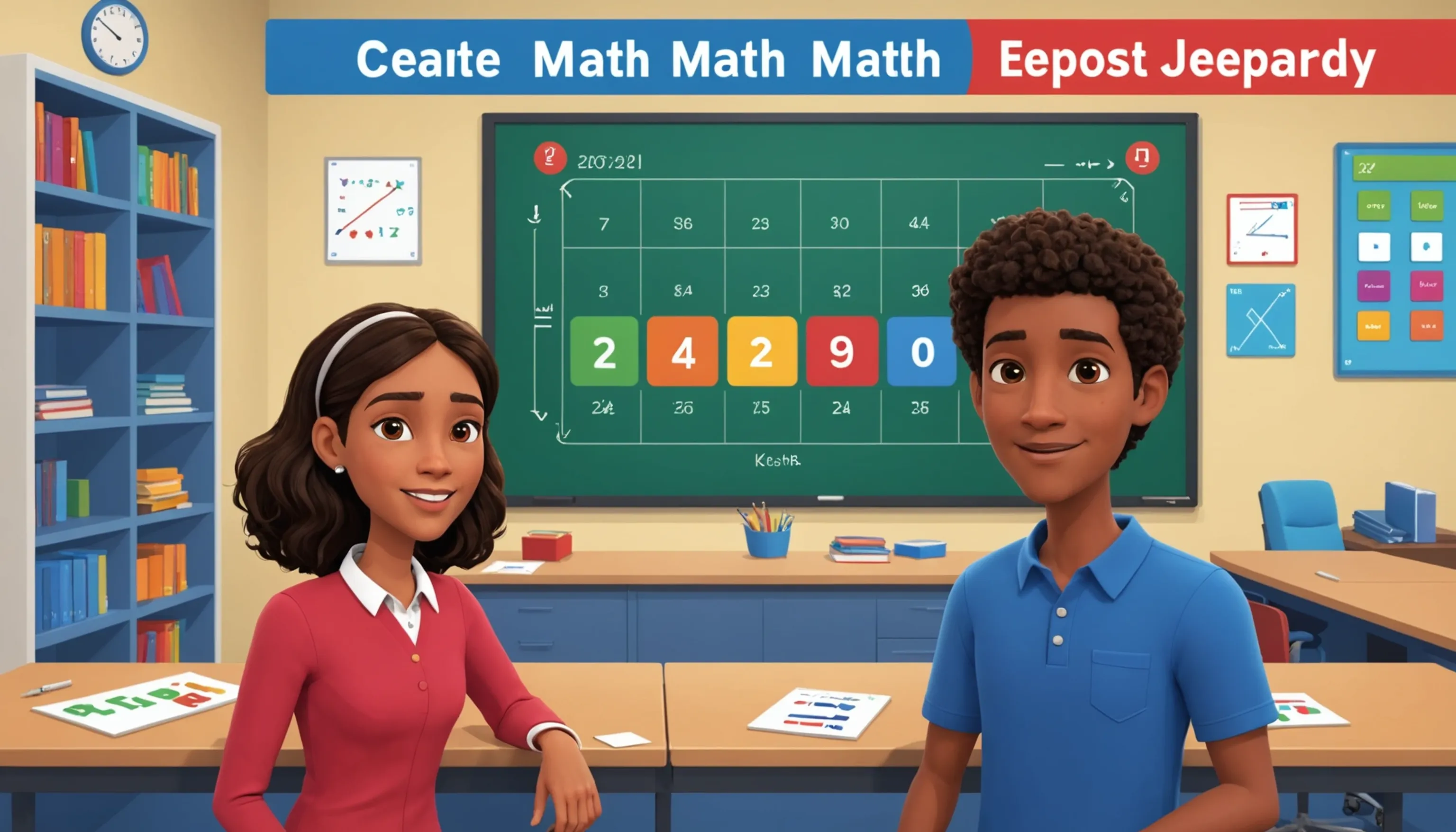Math Games for Teenagers
 HvWHenry van Wagenberg
HvWHenry van Wagenberg
Engaging Math Games for Teenagers
Engaging math games for teenagers are essential tools that make learning fun and interactive. These games not only help reinforce mathematical concepts but also boost critical thinking & problem-solving skills. Incorporating elements of competition and teamwork can significantly enhance motivation.
Examples of engaging math games include:
- Math Jeopardy: A quiz-style game that challenges students on various math topics.
- Math Bingo: A classic game that helps in practicing arithmetic operations.
- Escape Room Challenges: These require students to solve math puzzles to 'escape' within a time limit.
These games provide a dynamic way to engage teenagers in mathematics.
Benefits of Math Games for Teenagers
Math games offer numerous benefits for teenagers that extend beyond mere entertainment. Engaging in these games fosters a positive attitude toward mathematics, making the subject more approachable and enjoyable. Here are some key advantages:
- Enhances Problem-Solving Skills: Math games challenge students to think critically and develop strategies. They learn to approach problems from different angles, which is crucial for mastering complex concepts.
- Promotes Teamwork: Many math games are designed for groups, encouraging collaboration among peers. This teamwork helps teenagers develop social skills & learn how to communicate ideas effectively.
- Boosts Confidence: Successfully solving puzzles or winning a game can significantly improve a teenager's confidence in their mathematical abilities. This newfound self-esteem often translates to better performance in school.
- Makes Learning Fun: By incorporating elements of play, math games break the monotony of traditional learning. This fun approach keeps students engaged and motivated to learn.
- Improves Retention: The interactive nature of games helps reinforce mathematical concepts, making it easier for students to remember what they’ve learned.
Incorporating math games into learning not only makes the process enjoyable but also creates a stimulating environment where teenagers can thrive. Overall, these games serve as a bridge between learning and enjoyment, making math a subject that students look forward to exploring.

Popular Math Games for Teenagers
There are several popular math games for teenagers that effectively combine fun & learning. These games cater to a variety of interests & skill levels, making math more appealing. Here are some favorites:
- Math Jeopardy: A twist on the classic TV game show, Math Jeopardy allows students to choose categories and answer questions of varying difficulty. This game encourages quick thinking and reinforces knowledge across multiple math topics.
- Kahoot!: This interactive platform enables teachers to create quizzes that students can answer in real-time using their devices. Kahoot! makes learning competitive and exciting, with instant feedback on performance.
- Prodigy Math: An online game that combines fantasy elements with math challenges, Prodigy adapts to each student's skill level. This game keeps teenagers engaged while providing personalized math practice.
- Escape Room Math Challenges: These group-based activities require players to solve math puzzles to 'escape' within a time limit. They promote teamwork & critical thinking, making math a collaborative experience.
- 24 Game: A card game where players use addition, subtraction, multiplication, and division to reach the number 24. It enhances mental math skills and encourages quick calculations.
These popular math games not only help teenagers improve their math skills but also foster a sense of community and friendly competition, making learning a shared adventure.
How to Incorporate Math Games into Learning
Incorporating math games into learning can significantly enhance student engagement. Here are a few strategies:
- Start with Goals: Identify specific learning objectives to ensure the games align with the curriculum.
- Use Varied Formats: Incorporate different types of games, such as board games, online platforms, or group challenges, to cater to diverse learning styles.
- Schedule Regular Game Time: Set aside dedicated time each week for math games, making it a fun routine.
- Encourage Collaboration: Promote teamwork by having students play in pairs or groups to enhance social skills.
These strategies can make math a more enjoyable and impactful experience for students.

Using Online Platforms for Math Games
Using online platforms for math games has revolutionized the way teenagers engage with mathematics. These platforms offer a variety of interactive tools that can make learning both enjoyable and effective. Here are some key benefits and popular platforms:
- Accessibility: Online math games can be accessed from anywhere, allowing students to practice at their own pace. Whether on a computer or mobile device, teens can play games that suit their schedule.
- Personalization: Many online platforms, like Prodigy and Kahoot!, adapt to each student's skill level. This customization helps ensure that they are challenged without becoming overwhelmed.
- Instant Feedback: Online games often provide immediate feedback, allowing students to learn from their mistakes right away. This feature helps reinforce concepts and builds confidence.
- Variety of Content: Platforms like Mathletics and Coolmath Games offer a wide range of topics, from basic arithmetic to advanced algebra, catering to different learning needs.
- Engagement Through Competition: Many online platforms include leaderboards or multiplayer options, fostering a sense of competition among peers. This can motivate students to improve their skills.
Incorporating these online platforms into the learning process not only makes math more accessible but also encourages teenagers to engage actively with the subject, leading to better understanding & retention of mathematical concepts.
Creating a Math Game Night at Home
Creating a math game night at home is an excellent way to combine family fun with learning. This engaging event can help teenagers strengthen their math skills while enjoying quality time with family. Here’s how to set it up:
- Choose a Date and Time: Select an evening that works for everyone. Make it a weekly or monthly event to build anticipation.
- Select Games: Pick a variety of math games that cater to different skill levels. Some popular options include Math Bingo, 24 Game, and online platforms like Kahoot! or Prodigy. Ensure you have a mix of competitive and cooperative games.
- Set Up the Space: Create a comfortable and inviting atmosphere. Arrange seating, gather materials, and ensure everyone has access to necessary devices if using online games.
- Incorporate Snacks: Prepare some fun snacks to keep energy levels high. You could even theme your snacks around math, like “Pi” cookies or “Fraction” fruit slices.
- Encourage Participation: Get everyone involved, from parents to siblings. This inclusivity helps create a supportive environment and fosters teamwork.
By organizing a math game night, you turn learning into an enjoyable experience that brings families together. It’s a fun way to reinforce math skills while creating lasting memories.
Collaborative Math Games for Classrooms
Collaborative math games for classrooms foster teamwork and enhance learning experiences among students. These games encourage peer interaction while reinforcing mathematical concepts. Examples include:
- Math Relay Races: Teams compete to solve problems, passing answers down the line.
- Group Puzzles: Students work together to complete math-based puzzles, promoting critical thinking.
- Math Stations: Set up various stations with different games, allowing groups to rotate and collaborate on challenges.
By integrating collaborative math games into the classroom, teachers can create a dynamic learning environment that engages students and builds essential social skills.
Team-Based Math Challenges
Team-based math challenges are an exciting way to promote collaboration and critical thinking among students. These challenges not only reinforce mathematical concepts but also foster a sense of community within the classroom. Here’s how to effectively implement team-based math challenges:
- Form Teams: Divide students into small groups, ensuring a mix of skill levels in each team. This diversity allows students to learn from one another and encourages peer support.
- Set Clear Objectives: Define specific goals for the challenge, whether it's solving a certain number of problems or completing a project within a time limit. Clear objectives help maintain focus and drive.
- Incorporate Variety: Use different types of challenges, such as problem-solving scenarios, math scavenger hunts, or escape room-style puzzles. This variety keeps students engaged and caters to different learning styles.
- Encourage Communication: Promote discussion within teams, allowing students to share strategies and ideas. Effective communication is key to successful collaboration and helps build social skills.
- Provide Feedback: After the challenge, offer constructive feedback on both group dynamics and problem-solving strategies. This reflection helps students learn from their experiences.
By integrating team-based math challenges into the curriculum, educators create a dynamic and interactive learning environment. These challenges not only enhance math skills but also prepare students for real-world collaboration and problem-solving.
Math Escape Rooms for Groups
Math escape rooms for groups are an innovative and engaging way to combine problem-solving with teamwork. These interactive experiences challenge participants to solve math-related puzzles in order to 'escape' from a themed room within a set time limit. Here’s how to implement math escape rooms in an educational setting:
- Choose a Theme: Select a captivating theme that will interest students, such as a spy mission, haunted house, or treasure hunt. The theme sets the tone and can motivate students to participate actively.
- Create Puzzles: Design math puzzles that align with the curriculum, incorporating various topics like algebra, geometry, or statistics. Each puzzle should lead to the next clue, ensuring a cohesive flow throughout the escape room.
- Organize Teams: Divide students into small groups, promoting collaboration as they work together to solve puzzles. This format allows for diverse skill sets to shine and encourages peer learning.
- Set Time Limits: Establish a time limit for the escape room challenge, typically between 45 to 60 minutes. This creates a sense of urgency and excitement, driving students to think critically and work efficiently.
- Debrief After the Challenge: Once the challenge is complete, hold a debriefing session to discuss the strategies used, challenges faced, and lessons learned. This reflection reinforces the mathematical concepts covered.
Implementing math escape rooms fosters a fun, collaborative learning environment while enhancing students' problem-solving skills and mathematical understanding.
